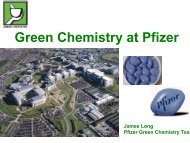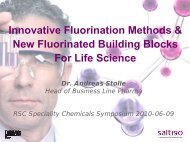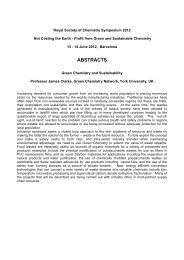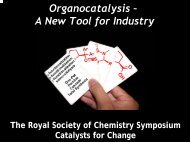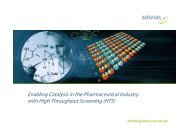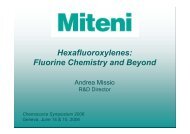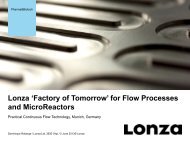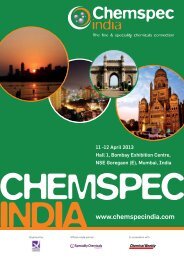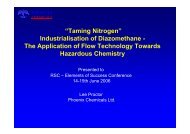Chemical Synthesis and Efficient Scale-Up in ... - Chemspec Events
Chemical Synthesis and Efficient Scale-Up in ... - Chemspec Events
Chemical Synthesis and Efficient Scale-Up in ... - Chemspec Events
You also want an ePaper? Increase the reach of your titles
YUMPU automatically turns print PDFs into web optimized ePapers that Google loves.
<strong>Chemical</strong> <strong>Synthesis</strong> <strong>and</strong> <strong>Efficient</strong><br />
<strong>Scale</strong>‐<strong>Up</strong> <strong>in</strong> Flow Reactors<br />
Paul Watts<br />
a<br />
Department of Chemistry, The University of Hull, Hull, HU6 7RX.<br />
b<br />
Chemtrix BV, Burgemeester Lemmensstraat 358, Geleen, The Netherl<strong>and</strong>s.<br />
RSC Speciality <strong>Chemical</strong>s Symposium 2011: Cont<strong>in</strong>uous Flow Technology<br />
Geneva, 15‐16 June 2011<br />
Visit Chemtrix at booth FC8 <strong>in</strong> the Flow Chemistry Pavilion
Benefits of Micro Reactor Technology<br />
• Increased reaction control<br />
– <strong>Efficient</strong> mix<strong>in</strong>g<br />
– Accurate control of reaction time, temperature <strong>and</strong> pressure<br />
– Improved atom efficiency, product selectivity, yield <strong>and</strong> purity<br />
– Increased run‐to‐run <strong>and</strong> reactor‐to‐reactor reproducibility<br />
– Increased catalyst turnover <strong>and</strong> lifetimes<br />
• Increased process safety<br />
– Due to rapid dissipation of heat of reaction<br />
– Low reactant hold‐up<br />
– Real‐time <strong>in</strong>‐situ analytical evaluation of reactions<br />
• Lower cost <strong>and</strong> shorter development cycles<br />
– Higher chemical selectivity lead<strong>in</strong>g to higher yield<br />
– Reduc<strong>in</strong>g the amount of reagents <strong>and</strong> catalyst
Benefits of Micro Reactor Technology<br />
• Increased reaction control<br />
– <strong>Efficient</strong> mix<strong>in</strong>g<br />
– Accurate control of reaction time, temperature <strong>and</strong> pressure<br />
– Improved atom efficiency, product selectivity, yield <strong>and</strong> purity<br />
– Increased run‐to‐run <strong>and</strong> reactor‐to‐reactor reproducibility<br />
– Increased catalyst turnover <strong>and</strong> lifetimes<br />
• Increased process safety<br />
– Due to rapid dissipation of heat of reaction<br />
– Low reactant hold‐up<br />
– Real‐time <strong>in</strong>‐situ analytical evaluation of reactions<br />
• Lower cost <strong>and</strong> shorter development cycles<br />
– Higher chemical selectivity lead<strong>in</strong>g to higher yield<br />
– Reduc<strong>in</strong>g the amount of reagents <strong>and</strong> catalyst<br />
– Reduc<strong>in</strong>g the size of the plant
Benefits of Micro Reactor Technology<br />
• Increased reaction control<br />
– <strong>Efficient</strong> mix<strong>in</strong>g<br />
– Accurate control of reaction time, temperature <strong>and</strong> pressure<br />
– Improved atom efficiency, product selectivity, yield <strong>and</strong> purity<br />
– Increased run‐to‐run <strong>and</strong> reactor‐to‐reactor reproducibility<br />
– Increased catalyst turnover <strong>and</strong> lifetimes<br />
• Increased process safety<br />
– Due to rapid dissipation of heat of reaction<br />
– Low reactant hold‐up<br />
– Real‐time <strong>in</strong>‐situ analytical evaluation of reactions<br />
• Lower cost <strong>and</strong> shorter development cycles<br />
– Higher chemical selectivity lead<strong>in</strong>g to higher yield<br />
– Reduc<strong>in</strong>g the amount of reagents <strong>and</strong> catalyst<br />
– Reduc<strong>in</strong>g the size of the plant<br />
– Faster scale‐up from lab to plant scale
Better def<strong>in</strong>ition of a ‘Micro’ Reactor<br />
• ‘Micro’reactors<br />
– Def<strong>in</strong>ed as a series of <strong>in</strong>terconnect<strong>in</strong>g<br />
channels formed <strong>in</strong> a planar surface<br />
– Channel dimensions of 10‐300 µm<br />
– Very small dimensions result <strong>in</strong> very fast<br />
diffusive mix<strong>in</strong>g<br />
– Rapid heat transfer<br />
– High throughput experimentation<br />
• ‘Flow’(or meso) reactors<br />
– Dimensions > 300 µm (up to 5 mm)<br />
– Mix<strong>in</strong>g much slower<br />
– Incorporate mixers<br />
– Throughput higher<br />
• Reactors fabricated from polymers, metals,<br />
quartz, silicon or glass<br />
• Why glass?<br />
– Mechanically strong<br />
– <strong>Chemical</strong>ly resistant<br />
– Optically transparent
Where is MRT be<strong>in</strong>g used?<br />
• Industry generally <strong>in</strong>troduces MRT where safety is a major concern<br />
– Xian <strong>Chemical</strong>s (Ch<strong>in</strong>a) ‐ 30 tonne/annum nitroglycer<strong>in</strong>e manufacture<br />
– DSM ‐ Ritter reaction (1700 tonnes manufactured to date)<br />
– DSM ‐ Nitration to form Naproxen <strong>in</strong>termediate (190 tonnes conc. HNO 3 <strong>in</strong> 7 weeks)<br />
• Case studies published show<strong>in</strong>g f<strong>in</strong>ancial sav<strong>in</strong>gs of us<strong>in</strong>g MRT <strong>in</strong> production<br />
• Drug discovery
Cont<strong>in</strong>uous Flow Concept: Facile <strong>Up</strong>‐Scal<strong>in</strong>g<br />
• Rapid scale‐up is a ‘strategic competitive advantage’<br />
– Process chemists require methodology that <strong>in</strong>creases reactor throughput<br />
without lengthy re‐optimisation steps<br />
Method Development<br />
Production<br />
<strong>Scale</strong>-up<br />
– Furthermore ideally want to optimise the process:<br />
• Fast<br />
• Us<strong>in</strong>g m<strong>in</strong>imal material
Labtrix<br />
• Reaction optimisation Features<br />
• Syr<strong>in</strong>ge pumps<br />
• Automated sample collection <strong>and</strong><br />
control<br />
• Tests at pressures of 25 bar <strong>and</strong><br />
temperatures of ‐15 to 195°C<br />
• St<strong>and</strong>ard <strong>in</strong>terchangeable reactors:<br />
1 µl 5 µl 10 µl<br />
5 +10 µl 10 µl<br />
• Catalyst reactor:
Rapid Reaction Evaluation<br />
MeOH<br />
Conversion (%)<br />
Optimal conditions:<br />
100.0<br />
90.0<br />
80.0<br />
70.0<br />
60.0<br />
(300s)<br />
50.0<br />
(180 s)<br />
40.0<br />
(150 s)<br />
30.0<br />
(60 s)<br />
20.0<br />
(30 s)<br />
10.0<br />
0.0<br />
0 50 100 150 200<br />
Temperature ( o C)<br />
• Micro reactor: 180 sec, 125 °C, 100% conversion<br />
• Batch stirred reactor 1 h, 125 °C cf. 93.6 % conversion<br />
Investigation:<br />
• Number of reactions: 200<br />
• Time taken to generate samples: 27 h<br />
• Volume of reactants employed: 5.97 ml (94.3 mg 1,3‐diketone)
Azide <strong>Synthesis</strong><br />
• Synthetically useful route to primary am<strong>in</strong>es, triazoles <strong>and</strong> isocyanates<br />
Disadvantages:<br />
• Exothermic reaction<br />
• Products are often hazardous substrates<br />
• Generation/build‐up of explosive <strong>in</strong>termediates<br />
• Diazidomethane <strong>and</strong> hydrazoic acid<br />
Why <strong>in</strong>vestigate under cont<strong>in</strong>uous flow?<br />
• Increase reactor safety<br />
– No headspace therefore reduced risk of HN 3<br />
build‐up<br />
– <strong>Efficient</strong> dissipation of heat generated<br />
• Increase productivity as a function of wider operat<strong>in</strong>g temperatures<br />
• Increase economic feasibility<br />
• Provide a generic method for the production of these versatile <strong>in</strong>termediates
Azide <strong>Synthesis</strong><br />
Operat<strong>in</strong>g Conditions:<br />
• Pressure‐driven flow<br />
• 0.66 M reagents<br />
• 25 to 195 °C<br />
• 25 Bar pressure<br />
• Optimised conditions<br />
• 30 sec residence time<br />
• 99 % conversion
Azide <strong>Synthesis</strong><br />
• Employ<strong>in</strong>g 0.66 M (EtOH) alkyl precursor <strong>and</strong> 0.66 M (50:50 aq. EtOH) NaN 3<br />
Order of reactivity was observed to be OMs > Br >> Cl<br />
– Us<strong>in</strong>g OMs derivative, the azide obta<strong>in</strong>ed at a throughput of 79 mg h ‐1 @195 ◦C<br />
• Analytically pure after an aqueous extraction<br />
– Cl derivative gave 70% conversion under these conditions<br />
• Potentially offers economic advantages overall
Physical‐Organic Chemistry ‐ K<strong>in</strong>etics<br />
O<br />
OH<br />
H 2N<br />
1 2<br />
MeOH<br />
N<br />
O<br />
3<br />
OH<br />
Plot k<strong>in</strong>etic curves<br />
Determ<strong>in</strong>e reaction order<br />
<strong>and</strong> rate constant<br />
Paal‐Knorr reaction:<br />
• Second order reaction<br />
• Rate constant @ 75 o C = 5.4 x 10 ‐3 L mol ‐1 s ‐1<br />
Optimal conditions: 2.5 M reagents, 37 s @ 150 o C affords the pyrrole 3 at a throughput of 418 mg h ‐1
Hydrolysis of p‐Nitrophenyl Acetate<br />
Reaction manifold:<br />
O<br />
aq. NaOH<br />
aq. HCl<br />
OH<br />
O<br />
O 2 N<br />
O<br />
O 2 N<br />
OH<br />
Reaction Conditions:<br />
• p‐Nitrophenyl acetate <strong>in</strong> toluene (0.05 M) <strong>and</strong> NaOH <strong>in</strong> DI H 2 O (0.5 M)<br />
• Total flow rate = 2 to 20 µl m<strong>in</strong> ‐1 , Temperatures = 25 to 150 °C<br />
Biphasic System:<br />
• Immiscibility of reactants affords segmented flow<br />
Direction of segmented flow<br />
Organic Phase<br />
Aqueous Phase
Hydrolysis of p‐Nitrophenyl Acetate<br />
Optimal conditions:<br />
• 60 sec, 125 o C afford<strong>in</strong>g 100% conversion<br />
Extraction of k<strong>in</strong>etic <strong>in</strong>formation:<br />
• Perform<strong>in</strong>g flow experiments at several reaction times enables the k obs to be<br />
readily extracted from the data generated<br />
– i.e. @ 75 ◦C, k obs = 0.0143 s ‐1 for p‐nitrophenyl acetate hydrolysis
Knoevenagel Reaction<br />
• Solution phase Knoevenagel reaction<br />
• 1:1 Ratio of reagents (0.5 M) <strong>in</strong> MeCN<br />
• Important to use appropriate reagent concentrations<br />
O<br />
O<br />
R<br />
R<br />
A<br />
B<br />
Me 2 NH<br />
CHO<br />
C<br />
O<br />
O<br />
D<br />
R<br />
R<br />
• 100 % conversion<br />
• Reaction very ‘atom efficient’<br />
• BUT product contam<strong>in</strong>ated with base!!<br />
• Traditional solvent extraction needed<br />
• This clearly reduces the advantages of flow reactors
Functionalised Reactors<br />
• Fabricate micro reactors which enable catalysts <strong>and</strong>/or supported<br />
reagents to be spatially positioned<br />
• Quantitative conversion to analytically pure product
Key Results of Heterogeneous Catalysis <strong>in</strong> Flow<br />
• Supported reagents deteriorate with time<br />
<strong>in</strong> batch reactions as a result of physical<br />
damage <strong>and</strong>/or loss<br />
100<br />
Run No. Conversion (%)<br />
1 98.3<br />
2 98.5<br />
3 98.3<br />
Conversion/%<br />
80<br />
60<br />
40<br />
20<br />
4 98.3<br />
5 98.4<br />
6 99.2<br />
7 99.1<br />
8 99.1<br />
0<br />
0 5 10 15 20<br />
Time/hr<br />
1s t Us e 2nd Use 3rd Use 4th Use<br />
9 100.0<br />
10 99.6<br />
11 99.3<br />
12 100.0<br />
• Reagents last longer <strong>in</strong> micro reactions as<br />
they suffer less damage <strong>in</strong> flow reactors<br />
• Higher effective catalyst concentration<br />
• Throughput ca. 10 mg/hr/channel<br />
13 100.0<br />
14 99.2<br />
Mean = 99.1 %, % RSD = 0.65<br />
Lab Chip, 2007, 7, 322
Indole <strong>Synthesis</strong><br />
• Core structure of many pharmaceuticals<br />
• Reaction conditions:<br />
• 0.1M Phenylhydraz<strong>in</strong>e, cyclohexanone, methanesulphonic acid <strong>in</strong> DMF<br />
• Heat<br />
O<br />
N<br />
H<br />
NH 2<br />
+<br />
H +<br />
NH<br />
Temperature<br />
(°C)<br />
Flow Rate<br />
(µLm<strong>in</strong> -1 )<br />
Indole<br />
(%)<br />
90 1 60.7<br />
95 1 81.3<br />
105 1 85.7<br />
105 0.5 93.3<br />
115 0.5 98.9<br />
• Note that excess reagents were not necessary<br />
• Similar results for other unfunctionalised ketones Tetrahedron, 2010, 66, 3861
• Reaction of ethyl pyruvate<br />
Indole <strong>Synthesis</strong><br />
• Acid caused product degradation ‐ very low yields of product<br />
N<br />
H<br />
NH 2<br />
EtO<br />
O<br />
O<br />
N<br />
H<br />
N<br />
O<br />
OEt<br />
N<br />
H<br />
O<br />
OEt<br />
• Reactor <strong>in</strong>corporat<strong>in</strong>g a solid supported acid: Amberlite IR‐120<br />
• 56% isolated yield at 70 o C <strong>in</strong> EtOH<br />
• Easier product isolation<br />
Tetrahedron, 2010, 66, 3861
Multi‐Step Indole <strong>Synthesis</strong><br />
• Aim to <strong>in</strong>corporate radiolabel<br />
• Challenge for cont<strong>in</strong>uous flow reactors:<br />
– Solvent compatibility between reaction steps<br />
• Screen<strong>in</strong>g study found MeCN to be the best compromise for both reactions<br />
• 46% overall yield at 75 o C <strong>in</strong> MeCN<br />
Tetrahedron, 2010, 66, 3861
<strong>Synthesis</strong> of α‐Am<strong>in</strong>onitriles: Increased Control<br />
Strecker Reaction:<br />
• Low yields, complex reaction mixtures laborious purification required<br />
– Problematic with aromatic aldehydes due to slow im<strong>in</strong>e formation<br />
Expensive Catalyst<br />
• Difficult to recover <strong>and</strong> recycle<br />
• Generation of acidic waste
Cont<strong>in</strong>uous Flow <strong>Synthesis</strong><br />
Immobilised catalyst<br />
Aims of Flow Reaction<br />
• Enable optimisation of im<strong>in</strong>e formation<br />
– To m<strong>in</strong>imise or prevent cyanohydr<strong>in</strong> formation<br />
• Employ a stoichiometric quantity of TMSCN <strong>and</strong> am<strong>in</strong>e<br />
• Recycle catalyst efficiently<br />
– Reduce degradation due to absence of stirr<strong>in</strong>g
Flow <strong>Synthesis</strong> of Im<strong>in</strong>es<br />
Reaction Conditions<br />
– 0.4 M Stock Solutions <strong>in</strong> MeCN<br />
– Micro Channel Dimensions = 150 µm (wide) x 50 µm (deep)<br />
Product (0.2 M)<br />
Conversion (%)<br />
100<br />
80<br />
60<br />
40<br />
20<br />
0<br />
25 µl m<strong>in</strong> ‐1<br />
0 20 40 60 80 100<br />
Total Flow Rate (µl m<strong>in</strong> -1 )<br />
• Reaction products analysed, off‐l<strong>in</strong>e, by GC‐MS<br />
– Identify optimal conditions for im<strong>in</strong>e formation
Cont<strong>in</strong>uous Flow Addition to Im<strong>in</strong>e<br />
0.2 M Stock Solutions <strong>in</strong> MeCN<br />
TMSCN<br />
Reagent Mix<strong>in</strong>g<br />
0.1 M Product<br />
Strecker Reaction<br />
100<br />
Conversion (%)<br />
80<br />
60<br />
40<br />
20<br />
0 20 40 60 80 100<br />
Total Flow Rate (µl m<strong>in</strong> -1 )
Multi‐Step Reaction<br />
Im<strong>in</strong>e<br />
Formation<br />
TMSCN<br />
Reagent Mix<strong>in</strong>g<br />
Strecker<br />
Reaction<br />
Flow: Quantitative Conversion (by NMR), 9.45 mg hr ‐1 (5.0 µl m<strong>in</strong> ‐1 )<br />
Batch: 64 % Conversion, stirred for 24 hr (1.5 eq. TMSCN)<br />
ICP‐MS Analysis:<br />
– Stirred Batch Reaction: 440 ppm Ru<br />
– Micro Reaction: No observable difference from the blank (MeCN)<br />
– Library of 51 compounds prepared<br />
OPRD, 2008, 12, 1001 Eur. J. Org. Chem., 2008, 5597
Epoxidation of Alkenes: Improved Safety<br />
• Epoxides are very useful reaction <strong>in</strong>termediates<br />
• Traditionally prepared us<strong>in</strong>g organic peracids<br />
– Hazardous on a large scale<br />
• Enzyme ‘greener’ but usually denatured by the reaction conditions<br />
• Avoided us<strong>in</strong>g a flow reactor where peracid generated <strong>in</strong> situ<br />
Experimental set‐up:<br />
• Reactor packed with Novozyme 435<br />
• Alkene 0.1 M <strong>and</strong> H 2 O 2 0.2 M <strong>in</strong> EtOAc<br />
Beilste<strong>in</strong> Journal of Organic Chemistry, 2009, 5, No 27
Epoxidation of Alkenes: Rapid Evaluation<br />
• Evaluation of optimum reaction conditions<br />
• Alkene 0.1 M <strong>and</strong> H 2 O 2 0.2 M <strong>in</strong> EtOAc<br />
Conversion (%)<br />
100<br />
90<br />
80<br />
70<br />
60<br />
50<br />
40<br />
30<br />
20<br />
10<br />
0<br />
• Optimum conditions:<br />
– Temperature 70 o C<br />
– Residence time 2.6 m<strong>in</strong>utes<br />
0 1 2 3 4 5 6<br />
Residence time (m<strong>in</strong>)<br />
• Higher temperatures denatured the enzyme<br />
70 C<br />
60 C<br />
50 C<br />
40 C<br />
27 C<br />
Beilste<strong>in</strong> Journal of Organic Chemistry, 2009, 5, No 27
(+)−γ‐Lactamase Enzymes<br />
• Hydrolysis of amides<br />
• Resolutions<br />
• CLEA from a cloned thermophilic enzyme packed <strong>in</strong>to reactor<br />
• Comomonas acidovorans<br />
• Enzyme found to be stable at 80 o C<br />
Biotechnology J., 2009, 4(4), 510-516
Substrate Screen<strong>in</strong>g<br />
• Experimental conditions<br />
• Optimum temperature 80 o C<br />
• Substrate 10 mmol/L concentration <strong>in</strong> phosphate buffer pH 7<br />
• Flow rate 1 ml/m<strong>in</strong><br />
Biotechnology J., 2009, 4(4), 510-516
Grignard Reaction<br />
• C‐C bond form<strong>in</strong>g → versatile reaction for the synthesis of alcohols, carboxylic<br />
acids, alkanes <strong>and</strong> ketones<br />
Problems Large‐scale Grignard Reactions:<br />
• Highly exothermic<br />
– Performed at low temperatures<br />
• Instantaneous, mix<strong>in</strong>g controlled reaction<br />
– Careful dos<strong>in</strong>g required to avoid hot spot formation<br />
– Compet<strong>in</strong>g side reactions <strong>and</strong> product decomposition<br />
Manipulation of Grignard Reagents us<strong>in</strong>g MRT:<br />
• Rapid dissipation of heat of formation ensures m<strong>in</strong>imal thermal gradient<br />
• Perception that <strong>in</strong>organic reagents cannot be h<strong>and</strong>led with<strong>in</strong> micro channel<br />
reactors
Grignard Reaction<br />
Effect of Reaction Time @ ‐15 o C:<br />
Optimal Conditions for 1‐Phenylpropan‐1‐ol:<br />
• Reactant concentration 0.5 M, stoichiometry 1:1, reaction time 2.5 s <strong>and</strong> reactor<br />
temperature ‐15 ◦ C<br />
• SOR reactor essential for rapid mix<strong>in</strong>g:
Translation of Microwave Methodology<br />
• Whilst microwaves have found widespread use <strong>in</strong> medic<strong>in</strong>al chemistry labs for<br />
the rapid screen<strong>in</strong>g of thermally activated reactions, scal<strong>in</strong>g is challeng<strong>in</strong>g<br />
Advantages of Flow:<br />
Reactions can be readily pressurised <strong>and</strong> ‘super‐heated’ like microwaves, but;<br />
• No solvent dependency on the actual reaction temperature<br />
• <strong>Efficient</strong> heat<strong>in</strong>g <strong>and</strong> accurate control of reaction time<br />
• Reactions can be scaled<br />
Model Reaction:<br />
• To demonstrate this, the follow<strong>in</strong>g etherification reaction was performed us<strong>in</strong>g Labtrix ®<br />
S1 <strong>and</strong> the data obta<strong>in</strong>ed compared with the literature 1<br />
1. J. D. Moseley, Org. Biomol. Chem., 2010, 8, 2219-2227.
Translation of Microwave Methodology<br />
Reaction Conditions:<br />
• Residence time 10 m<strong>in</strong>s<br />
• 1.30 M Phenol <strong>and</strong> DCNB <strong>in</strong> DMA<br />
• Perform<strong>in</strong>g the reaction <strong>in</strong> MeCN<br />
– Equivalent conversions obta<strong>in</strong>ed
Facile <strong>Up</strong>‐Scal<strong>in</strong>g<br />
• Rapid scale‐up is a ‘strategic competitive advantage’<br />
– Process chemists require methodology that <strong>in</strong>creases reactor throughput<br />
without lengthy re‐optimisation steps<br />
Method Development<br />
Production<br />
<strong>Scale</strong>-up<br />
• Reaction channel dimensions <strong>in</strong>creased<br />
– ‘micro’ 300 µm x 120 µm to ‘meso’ 1.4 mm x 1.0 mm
<strong>Efficient</strong> <strong>Scale</strong> <strong>Up</strong> ‐ Mix<strong>in</strong>g Technology<br />
• Need to ensure that the mix<strong>in</strong>g is the same <strong>in</strong> all reactor designs<br />
• Staggered Oriented Ridges (SOR) fabricated <strong>in</strong> the channels<br />
1 Unit<br />
2 Units<br />
3 Units
Mix<strong>in</strong>g Efficiency us<strong>in</strong>g Fourth Bourne Reaction<br />
[DMP] (M) a<br />
Mix<strong>in</strong>g Time (ms)<br />
0.05 31.7<br />
2.5 x 10 -2 63.5<br />
1.25 x 10 -2 127.0<br />
6.25 x 10 -3 254.0<br />
a<br />
After mix<strong>in</strong>g but before reaction (50 % Stock)<br />
< 4 % hydrolysis = efficient mix<strong>in</strong>g
Mix<strong>in</strong>g Efficiency us<strong>in</strong>g Fourth Bourne Reaction<br />
Validate the Scal<strong>in</strong>g Pr<strong>in</strong>ciple:<br />
• The reaction was repeated <strong>in</strong> a 0.8 ml conta<strong>in</strong><strong>in</strong>g same SOR mixer as a<br />
micro reactor<br />
x 800<br />
Reactor Volume = 1.0 µl<br />
Reactor Volume = 0.8 ml
Mix<strong>in</strong>g Efficiency us<strong>in</strong>g Fourth Bourne Reaction<br />
> 99 % < 254 ms<br />
> 96 % Mix<strong>in</strong>g < 159 ms<br />
63.5 ms<br />
31.7 ms
<strong>Chemical</strong> Appraisal of Plantrix by J&J<br />
<strong>Chemical</strong> Appraisal:<br />
• Plantrix chemically evaluated by J&J,<br />
a multi‐national pharmaceutical company<br />
– Details of the process are confidential<br />
Eschweiler Clarke Reaction:<br />
• Us<strong>in</strong>g Dynochem software, the optimal conditions to maximise target<br />
<strong>in</strong>termediate (+ m<strong>in</strong>imise by‐product formation), were predicted based on 5<br />
batch reactions<br />
→ 56 s @ 122 ºC<br />
• Outside the operat<strong>in</strong>g conditions safely atta<strong>in</strong>able <strong>in</strong> batch reactors, CO 2 ↑<br />
Solution: Use a cont<strong>in</strong>uous flow reactor<br />
Luc Moens, Flow Chemistry Conference, Munich, March 2011.
<strong>Chemical</strong> Appraisal of Plantrix by J&J<br />
Reaction Conditions Evaluated with<strong>in</strong> Plantrix:<br />
• Residence times = 15, 30 <strong>and</strong> 60 s<br />
• Reactor temperatures = 120 to 145 ºC → Analysis = Offl<strong>in</strong>e HPLC<br />
– 20 conditions screened <strong>in</strong> 3 h<br />
Results:<br />
Batch Predicted Optimal Conditions Plantrix ®<br />
N-Methyl Derivative 87.0 93-93.5 93.5<br />
By-product 10.0 1.7-2.5 2.1<br />
Others 3.0 1.0-1.2 -<br />
• Reaction translated to a 1 litre PFA reactor for 100 kg h ‐1 production<br />
• 3 Validation batches performed, results presented to the FDA who confirmed;<br />
‘no additional analytical PAT tools were required for production’
Plantrix ® Production Capacity<br />
<strong>Chemical</strong> Appraisal:<br />
• Plantrix chemically evaluated by J&J,<br />
a multi‐national pharmaceutical company<br />
– Details of the process are confidential<br />
Model System:<br />
• 0.5 M Product concentration (MW = 200), 1 m<strong>in</strong> reaction time<br />
Labtrix ® Plantrix ®<br />
Micro Reactor 1 Channel 8 Channel 8 Channel<br />
Volume per Reactor Channel 10 µl 0.8 ml 6.5 ml 6.5 ml<br />
Micro Reactors 1 1 1 1<br />
No. Reactors per Holder 1 1 1 10<br />
Volume per Holder 10 µl 0.8 ml 6.5 ml 65 ml<br />
Throughput* 60 mg hr -1 4.8 g hr -1 39.0 g hr -1 390 g hr -1 (9.36 kg day -1 )<br />
• Us<strong>in</strong>g a range of product configurations, you can;<br />
– M<strong>in</strong>imise reagent use (0.8 ml), or tailor production rates
Conclusions<br />
• Micro reactors allow the rapid optimisation of reactions<br />
– Rapid process development<br />
• Increased reaction control<br />
– Higher purity<br />
– Higher conversion<br />
– Higher selectivity<br />
• More reproducible synthetic procedures<br />
– Operator <strong>in</strong>dependent synthesis<br />
• Increased catalyst turnovers <strong>and</strong> lifetimes<br />
– Easier purification/isolation<br />
• Increased process safety<br />
– Due to rapid dissipation of heat of reaction<br />
– Low reactant hold‐up<br />
• Equipment for method development <strong>and</strong> production developed<br />
Visit Chemtrix at booth FC8 <strong>in</strong> the Flow Chemistry Pavilion



